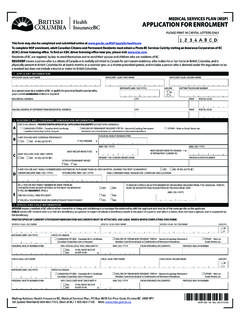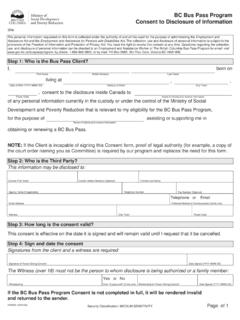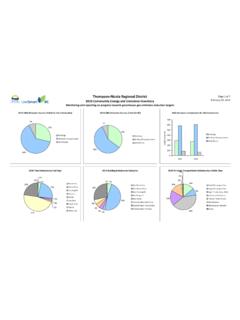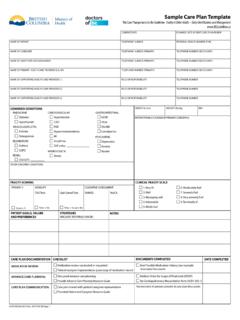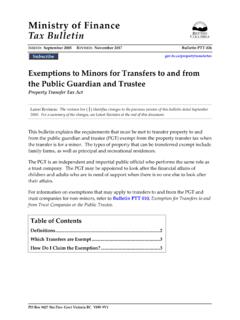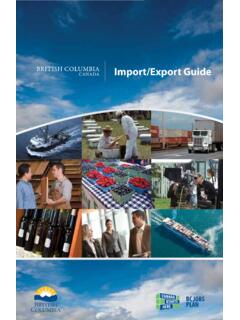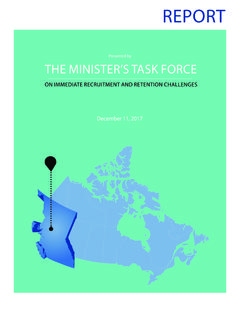Transcription of Words Matter - Guidelines on Using Inclusive Language in ...
1 Guidelines on Using Inclusive Language in the workplace Page | 2 | Words Matter : Guidelines on Using Inclusive Language in the Workplace CONTENTS Acknowledgement .. 3 Using Inclusive Language in the 4 Respectful Workplaces .. 5 Guiding Principles .. 6 Unconscious Bias and Embedded Metaphors .. 7 A Closer Look: Inclusive Language and the BC Human Rights Code .. 8 Culture and Ancestry .. 9 Indigenous People .. 11 In-Group Terms .. 12 Political Belief .. 14 15 Marital or Family Status .. 16 Disability .. 17 sexual orientation , gender Identity or Expression .. 19 Pronouns .. 20 Gendered Exemplification .. 21 Gendered Pronouns .. 21 Age .. 24 Promote Respect in the Workplace .. 25 References .. 26 Page | 3 | Words Matter : Guidelines on Using Inclusive Language in the Workplace Acknowledgement The BC Public Service Agency acknowledges with gratitude the contributions of our colleagues across the BC Public Service the many voices, perspectives, and experiences that have contributed to this document.
2 These Guidelines are a living document that will be enriched by continued feedback and conversations. Page | 4 | Words Matter : Guidelines on Using Inclusive Language in the Workplace Using Inclusive Language in the Workplace Inclusive Language is Language that is free from Words , phrases or tones that reflect prejudiced, stereotyped or discriminatory views of particular people or groups. It is also Language that does not deliberately or inadvertently exclude people from feeling accepted. The use of Inclusive Language plays an important role in promoting higher employee engagement, superior customer service and increased productivity all important aspects of a positive work culture. Building and maintaining respectful workplaces is a shared responsibility in the BC Public Service.
3 Paying attention to how Language is used in the workplace is a key part of this responsibility. Language is not always intended to exclude a person or a group, but it may unintentionally have that effect. Becoming conscious of how Language impacts others can help prevent feelings of exclusion and discomfort in the workplace. This guide sets out some key guiding principles and suggestions to support Using Inclusive Language . This guide does not set out to be comprehensive or definitive because Language is constantly evolving. Rather, the intention of these Guidelines is to provide supervisors and employees with supports to promote a greater sense of inclusion and engagement in the workplace. You can build from these Guidelines by remaining curious, seeking out information from diverse, thoughtful authors, and asking appropriate questions about what Language might mean to others and inquiring into others experiences, needs and concerns.
4 In taking these steps, supervisors and employees can better reinforce inclusion and diversity in the workplace. Having a curious and empathetic mindset to approaching the use of Inclusive terms will be helpful to the application of these Guidelines to various forms of communications. Honouring, welcoming and championing inclusion may entail seeking out unique points of view and perspectives. Talking about Inclusive Language welcomes diverse people into conversations and offers the potential to deepen understanding and connection. This guide supports BC Public Service employees to model the use of Inclusive Language in the workplace and with citizens. Page | 5 | Words Matter : Guidelines on Using Inclusive Language in the Workplace Respectful Workplaces When employees are hired and take their Oath of Employment, they are asked to officially commit to upholding the Standards of Conduct for Public Service Employees, which address workplace behaviour and require all employees to contribute to a positive work environment.
5 The BC Human Rights Code protects a person from discrimination in hiring or on the job if the discrimination is based on one or more of the following protected grounds: Race, colour, ancestry, place of origin Political beliefs Religion Marital status Family status Physical or mental disability Sex sexual orientation gender identity or expression Age Conviction of a criminal or summary offence not related to the employment Discrimination and harassment as related to any of the protected grounds violate the fundamental rights, dignity and integrity of an individual. There are policy statements about workplace behaviour and conduct that require all employees to behave respectfully, collaboratively and in ways consistent with the corporate values of the BC Public Service.
6 These policy statements and collective agreements include: Discrimination and Harassment in the Workplace Standards of Conduct Occupational Safety and Health BCGEU Collective Agreement Article , Article , Article , Article PEA Collective Agreement Article , Article The BC Public Service has one overarching corporate value integrity and six core corporate values: curiosity, service, passion, teamwork, accountability and courage. These Guidelines on Using Inclusive Language in the workplace are an example of how public service employees demonstrate these values. Page | 6 | Words Matter : Guidelines on Using Inclusive Language in the Workplace Guiding Principles In Using Inclusive Language , it is helpful to keep these principles in mind: People first. Many general principles provided in this guide involve seeing the person as an individual first and becoming aware of diverse audiences.
7 Words Matter . Not only do terms and expressions allow people or groups to feel excluded, but they can also convey or embed stereotypes, expectations or limitations. Language changes. All Language changes to reflect the values of society. As Language changes, so do the norms that deem what is socially and grammatically acceptable. Mindset matters. It is important to keep a curious and empathetic mindset. Most Language has evolved to reflect the values and norms of the mainstream or dominant culture, and if a person is a member of that culture, they have had the privilege to feel included the majority of the time. That is not the case for everyone. Inclusive terms. Try to make your Language and your message as Inclusive as possible. For example, when speaking to an audience, make sure your speech relates to all your listeners and uses gender - Inclusive Language .
8 Use of generalizations or stereotypes. No Matter your audience, be cautious about making sweeping statements about any social group. This includes making personal assumptions based on gender , culture, ancestry, age and other categories. Use of prejudiced Language . Take time to educate yourself about what Words , phrases, or perspectives may offend your listeners. One goal of an audience-centered, Inclusive speaker is to be cautious about prejudiced Language or remarks. Self-reflection. Bring self-awareness to the times when you use Words and expressions in writing. Think about your intentions for Using a phrase, whether it has any origins, and whether there is a more Inclusive way to state what you are trying to say. It may also be helpful to ask: Does the individual or group have preferred terms?
9 Does the Language reflect the diversity of the intended audience? Is reference to a person s gender , culture, ethnicity, age, etc. relevant? Am I staying open and curious, and encouraging others to do the same? Is there a need to consult a formal style guide such as The Canadian Press Stylebook, APA Style, or other resources such as Elements of Indigenous Style: A Guide for Writing by and about Indigenous Peoples for guidance on written communication standards? Page | 7 | Words Matter : Guidelines on Using Inclusive Language in the Workplace Unconscious Bias and Embedded Metaphors Many metaphors and sayings in the English Language have become so frequent that a person may not realize their origins, and they can reinforce a stereotype or bias and marginalization without realizing it.
10 Unconscious bias and embedded metaphors may also be reinforced through popular culture and media, therefore blurring the distinction between Inclusive and non- Inclusive Language . When metaphors or comparisons are used, consider whether a stereotype or a negative view of a social group is inadvertently being promoted. For example, welshing on a bet, or being gyped are inappropriate for use as they promote negative stereotypes about identifiable groups. The English Language often embeds gender assumptions and stereotypes, and it is best to replace these with more Inclusive terms. Likewise, cultural metaphors and comparisons often misrepresent cultural practices. Be mindful of terms and phrases that may be considered cultural misappropriation. For example, it is inappropriate to use the phrase low man on the totem pole to indicate hierarchy, or the term pow-wow to mean talk.
